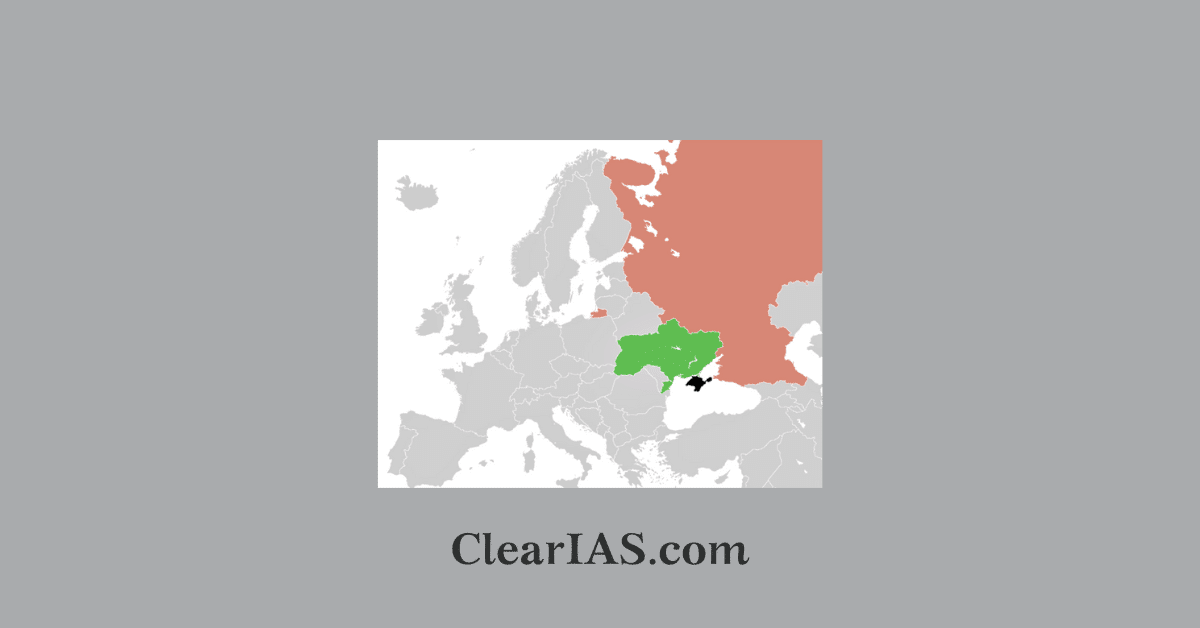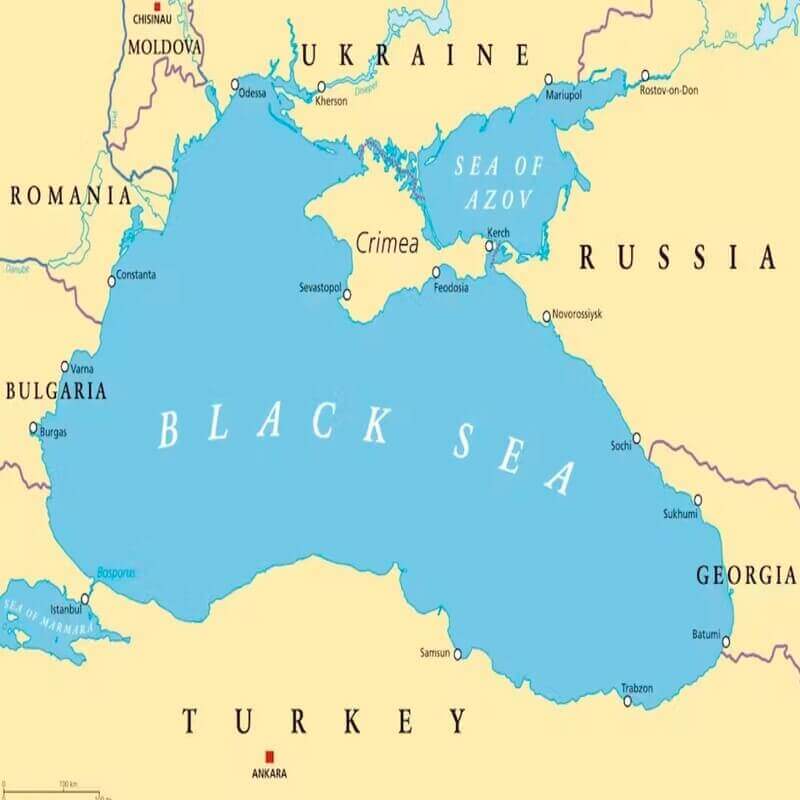
The 2014 Crimean crisis was a geopolitical and territorial conflict that centered around the Crimean Peninsula, which is located in the Black Sea and was part of Ukraine. The crisis culminated in the annexation of Crimea by Russia, leading to tensions between Russia, Ukraine, and the international community. Read here to know the events associated with it.
Ukraine Crisis makes news headlines almost every day now. In this globalized world, no event occurs in isolation. Whether or not involved, every crisis, revolution, or peace treaty has an impact on almost all nations.
Crimea has historical and cultural ties to both Ukraine and Russia. It was transferred from the Russian Soviet Federative Socialist Republic to the Ukrainian Soviet Socialist Republic within the Soviet Union in 1954. After the dissolution of the Soviet Union in 1991, Crimea became part of an independent Ukraine.
We shall analyze the background details of the Crimean Crisis in layman’s language.
Euromaidan, 2014 Ukrainian revolution and Crimean crisis
When we analyze the Ukraine crisis, we should note that there are multiple events involved like the Euromaidan, the 2014 Ukrainian revolution, and the 2014 Crimean crisis, and every event has a close connection with each other.
Since the events started with Euromaidan, in this article we have included everything currently related to Ukraine in the blanket cover of Euromaidan.
The crisis was triggered by Ukraine’s political turmoil in 2013-2014, known as the Euromaidan protests.
Euromaidan: Leading to the Crimean crisis
The Euromaidan was a wave of demonstrations, civil unrest, and revolution in Ukraine, which began on the night of 21 November 2013 with public protests demanding closer European integration.
President Viktor Yanukovych’s government announced Ukraine is abandoning an agreement to strengthen ties with the European Union and is instead seeking closer cooperation with Moscow. This was the immediate cause of the Euromaidan protests. There were other reasons too.
Causes of Euromaidan
- Suspension of the Ukraine–European Union Association Agreement by the government.
- Russian foreign policy.
- The threat of Russian trade sanctions.
- Government corruption.
- Police brutality.
Goals of Euromaidan
- The signing of the EU Association Agreement and Free Trade Agreement.
- Impeachment of President Viktor Yanukovych.
- Re-adoption of the 2004 Constitution of Ukraine amendments.
- International sanctions against Yanukovych and Azarov government members.
- Rejection of Customs Union membership.
Impact of Euromaidan
The Euromaidan protests eventually led to the ousting of President Yanukovych in February 2014. This power shift was seen as a setback for Russia’s interests in Ukraine.
- 2014 Ukrainian Revolution.
- Impeachment of Viktor Yanukovych.
- Return of 2004 constitution.
- Oleksandr Turchynov becomes Acting President.
- Early presidential election.
- Implementation and subsequent cancellation of laws restricting civil liberties.
- Former Ukrainian prime minister and opposition leader, Yulia Tymoshenko freed from jail.
- Occupation of local governments.
- Banning of Party of Regions by local governments under the control of anti-government activists.
- Resignation of Prime Minister Mykola Azarov.
- President Yanukovych offers opposition to the position of Prime Minister of Ukraine.
- The economic situation worsened, including credit downgrading by American credit agencies like Moody’s.
- Beginning of the Crimean Crisis and invasion by Russia.
- The new Cabinet of Ukraine resumed preparations for the signing of the EU Association treaty.
Ukrainian Revolution (18–23 February 2014)
The 2014 Ukrainian revolution began with a series of violent episodes of civil unrest in Kyiv, Ukraine, as part of Ukraine’s ongoing Euromaidan protest movement against the government.
The conflict escalated rapidly, leading to the downfall of the government of President Viktor Yanukovych and the setting up of a new government to replace it within a few days. Yanukovych fled to Russia and is wanted in Ukraine for the killing of protesters.
In brief, the 2014 Ukrainian revolution was anti-Yanukovych who is pro-Russia. Those who protested wanted close Ukraine-EU relations and not a Ukraine-Russia partnership.
The 2014 Crimean Crisis

The Crimean Crisis happened when pro-Russian forces seized control of the Crimea region. The Causes of the Crimean Crisis can be summed up below :
- Opposition to the Euromaidan movement.
- Opposition to the Yatsenyuk Government.
- The Verkhovna Rada’s vote on 23 February to repeal the language law that protected minority languages.
Amid the political upheaval in Ukraine, Russia intervened by deploying troops to Crimea, which had a significant Russian-speaking population.
In March 2014, a controversial referendum was held in Crimea, in which a majority of participants voted in favor of joining Russia.
The international community, including Ukraine and Western countries, condemned the referendum as illegal and not reflective of the will of the people.
Who is in charge of Ukraine? Different perspectives!
- Russia’s take: Viktor Yanukovych remains Ukraine’s elected leader, and Ukraine’s new government is illegitimate. Russian United Nations envoy Vitaly Churkin called it an “armed takeover by radical extremists.”
- Ukraine’s take: Ukraine has a legitimate government and is set to have new presidential elections on May 25. “Let’s allow that to work,” Ukrainian Ambassador to the U.N. Yuriy Sergeyev said.
- United States take: Yanukovych abandoned his post last month, fled the country, and was then voted out of office by Ukraine’s democratically elected parliament.
Do Russian troops have a right to be in Crimea?
Russia’s take: Yes. A treaty between the neighboring nations allows Russia to have up to 25,000 troops in Crimea. Yanukovych requested Russia to send military forces.
Ukraine’s take: No. Russian troops amassing in Crimea and near the border with Ukraine are an “act of aggression.”
United States take: No, and Russian President Vladimir Putin is playing a dangerous game. The consequences of military action “could be devastating,”.
What is the Russian interest in the Crimean Peninsula?
Russia’s take: Russia has said its parliament approved Putin’s use of military force to protect Russian citizens in the Crimean peninsula.
Ukraine’s take: There’s no evidence of any threat to Russians inside Ukraine. Russia wants to annex Crimea.
United States take: Russia is responding to its historic sensitivities about Ukraine, Crimea, and their place in Moscow’s sphere of influence. Russia fears that Ukraine is falling under European or Western influence.
US-Russia-Ukraine Diplomatic Talks
- U.S. Secretary of State John Kerry held the first direct talks with his Russian counterpart as Washington warned Moscow it risked losing its coveted G8 place over the worst East-West crisis since the end of the Cold War.
- Crimea’s parliament voted for the region to become part of Russia, and to hold a referendum in 10 days on endorsing the move.
- Ukraine’s interim economy minister dismisses the move as “unconstitutional”.
- EU leaders are holding an emergency summit to decide their response to Russia’s troop deployment in Crimea.
- The US imposes visa restrictions on people who are “threatening the sovereignty and territorial integrity of Ukraine”
Conclusion
The former President of Ukraine who was pro-Russia was ousted as part of the Euromaidan protests (2014 Ukraine Revolution to be precise).
The protesters generally were of pro-west (read EU and US) attitude and demanded closer EU relations. As the President of Ukraine sought Russia’s help, Russian troops entered the Crimean peninsula in Ukraine. Crimea’s parliament voted for the region to become part of Russia, and to hold a referendum in 10 days on endorsing the move.
The annexation of Crimea was met with strong condemnation from many countries and led to diplomatic tensions between Russia and Western nations. The United States and the European Union imposed economic sanctions on Russia in response.
The crisis further exacerbated tensions between Ukraine and Russia. The eastern regions of Donetsk and Luhansk, with large Russian-speaking populations, also witnessed separatist movements and conflict between pro-Russian rebels and the Ukrainian government.
The annexation of Crimea violated Ukraine’s territorial integrity and international law. The United Nations General Assembly passed a resolution that affirmed Ukraine’s sovereignty over Crimea and condemned Russia’s actions.
The 2014 Crimean crisis marked a significant turning point in the relationship between Russia and the West, and it had far-reaching implications for regional stability and international norms.
The issue of Crimea’s sovereignty remains unresolved, and tensions between Russia and Ukraine persist to this day.
Ukrainian- Crimean Crisis and UPSC!
An understanding of key events in Ukraine’s political crisis would help to answer the 2014 UPSC interview questions. Adding below, are some important keywords related to the Ukraine crisis. Check them out. Interested aspirants may explain some of them in the comments.
Keywords related to the Ukrainian Revolution and Crimean Crisis
Keywords: Ukraine crisis, Crimea coup, Russia Ukraine dispute, Simferopol, Crimean airports, Sevastopol, Kerch ferry terminal, Vladimir Putin, Arseniy Yatsenyuk, Viktor Yanukovych, Oleksandr Turchinov, Euromaidan, Orange Revolution.
Eg: Euromaidan: Protest which attracted around 300,000 people on Kyiv’s Independence Square, known as the Maidan, the largest since the 2004 Orange Revolution. Activists seized Kyiv City Hall.






very nice explanation sir
Hey Alex .. that’s a nice write up. But I would like to suggest some things.
1. Why is US trying to get involved in this ?
2. What is Indian Govt.’s view on this ? Will it support Russia or EU ?
3. How does Ukraine’s ties with EU will affect all the economies ?
That would be really helpful.
Thanks.